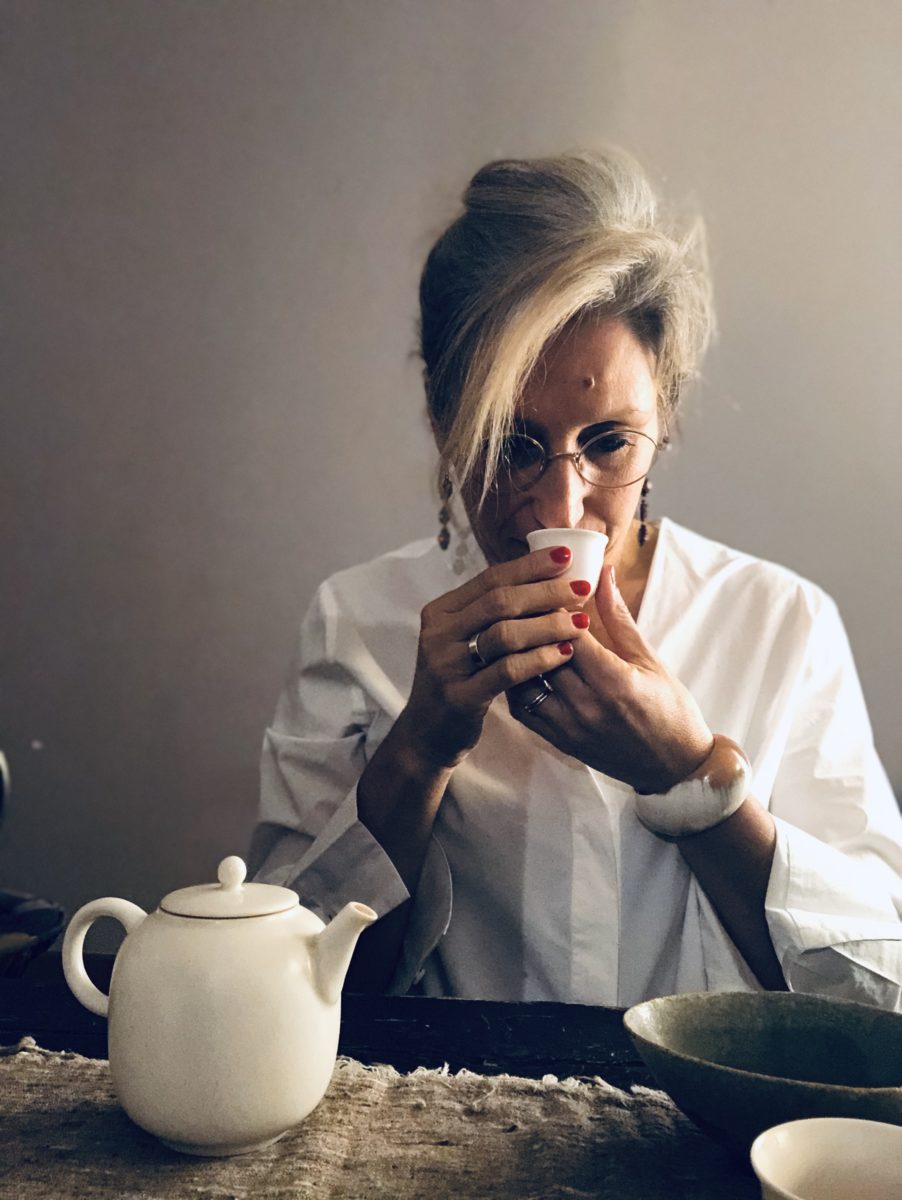
Carine Baudry is a flavourist and an expert taster who graduated from ISIPCA, the International Institute of Perfumery and Aromatics. She specializes in tea and infusions. Since she was a child, Carine has been fascinated by the magic of scents and the magic of the five senses. As a little girl, she could already see herself traveling to distant lands to discover new flavors. Her first book on spices, given to her by her father at age 10, served as a guide for her wildest dreams. This quest has always animated her, and she has made it her profession.
After ten years of working in flavor creation, she felt the need to connect more with nature and, rather than copying it, wanted to understand it better, explore it and bring it to light. She chose tea as a path to her aspirations and became a taster for a major tea brand. Baudry ran its training center for ten years, where she created a teaching method that focused on the olfactory approach. She developed a sensory and descriptive dialectic of teas still used today. From this adventure was born a “sensory box tool” that is very useful for everyone to develop their own knowledge of the beverage.
She is the founder of the La Quintessence du Thé, a company offering advice and sensory expertise support. In this context, she assists companies, restaurants, and individuals in learning about tea and its tasting, as well as tea producers in optimizing their processes and enhancing the value of their products. She has worked as an international expert on projects in Laos and Vietnam.
Baudry is also responsible for sourcing tea for the Haute Manufacture de thé” brand, Nunshen. She continues her collaboration by creating infusions for the “Chic des Plantes” brand.
She actively participates in the work of the “Agence pour la Valorisation des Produits Agricoles-AVPA” as president of the jury for the world tea and infusion contest.
She travels the world’s tea plantations in order to source and better understand the magic of tea to share it with all the actors, producers, distributors, and consumers. Meeting the people who work to bring us these marvelous products, passing on an understanding of the smells and textures, and teaching consumers to understand and respect a product are all things that guide her path and drive her.
“This is a wonderful opportunity for me to meet people! I don’t know of any better place to feed my creativity by discovering other cultures, different types of culinary art, plants, and spices that are always surprising!”
She has kept the link with the world of scents and perfumery by teaching at the perfume school of Versailles (ISIPCA) for more than five years.
— Anne-Frédérique Dayraut trained in India with the expert Vikram Mittal and is the representative of his tea house in France. She is the founder of her own brand, the Sanskriti Collection.
Anne: What did you do before working in the tea business? Did this change what you thought you would do as a career?
Carine: Before working in the field of tea, I studied perfumes and aromas at ISIPCA, the School of the Nose in Versailles, and then worked for ten years in the creation of fragrances. This job allowed me to dissect nature and observe it since the mission is to copy it and explore all the odorous molecules of each food. That was my first job. While doing this job, I worked in the creation and world of smells, which fascinated me.
Anne: When did you decide to make tea tasting your job? What first interested you in tasting?
Carine: I was somewhat disturbed by exploring and copying at one point. I wanted to abandon this approach to explore nature, to understand its richness and subtlety. That was the first point. In parallel with this job, I occasionally intervened in courses on the sensory approach and tasting at the Tea School (editor’s note: at the Palais Des Thés). I was touched by people who realized they had a nose. I realized that these people tasted better with an accompaniment and an explanation. It touched me as I wasn’t aware of it. As it was my job, it was something spontaneous at home, systematic, and normal. To be able to transmit it was a point that I liked very much.
Anne: What did it feel like that you came to meet the tea industry? Where is this meeting point?
Carine: This reflection told me, “I will go and get what nature can offer and offer.” It was a meeting with Lydia Gautier that made me start the courses on tasting. Lydia had asked me to intervene specifically on the sensory part. I have always loved tea, and tea is a sensitive story at home. I used to share tea moments in the morning with my dad. He gave me all the openness and sensitivity toward the sensory universe. So I started to step into this universe and, in time, it seemed obvious to me that I had to put my suitcase in this place.
I started from the approach on tasting, creating and exploring all the odorous molecules in nature in general, and then I began to open the door to the world of tea and tasting. I decided in 2003 to make it my job. I didn’t necessarily have a clear vision of what it could be, but my goal was to invent it. In my previous missions, I created in a laboratory working with raw materials and odorous molecules. The idea was to leave the laboratory to recreate a new profession where I could use all my background, my expertise in the knowledge of these odorous molecules, the ability also of understanding how they could unite, to use my nose, my creative approach, and finally to link it with my sensitivity. This profession is based partly on tasting and understanding the processes and methods of preparation to optimize what is in the cup. It also involves training others to develop their understanding of tea and sensory.
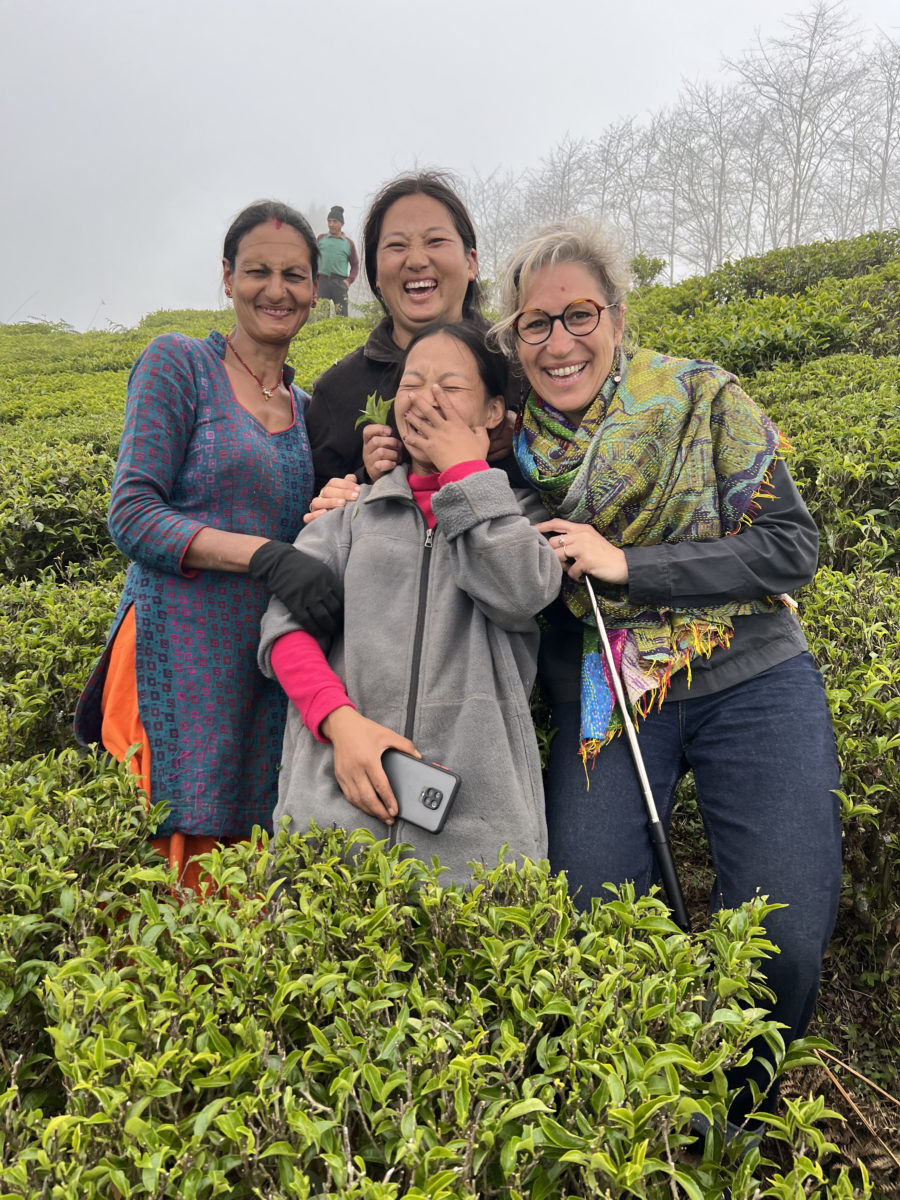
Anne: It was a new idea. So you were a pioneer in this field?
Carine: Yes, it was. Today, we see all these tasting sheets. There was nothing 20 years ago. I came from this universe, so it was something I mastered well. It was already practiced in the world of wine but not at all in the world of tea. My goal was to put at the center a sensory dialectic for all tea, a common sensory language that could be taught. It was a time when online sales were growing. It’s complicated an online sale because you have to tell a sensory story. We can tell quite easily the history of tea, where it comes from etc., but on the other hand, what also brings the center of pleasure when we taste a tea and what also influences our choice is what we will feel: is it rich, does it have this or that note, does it have this or that texture? So it was a question of setting up this vocabulary to be able to describe a tea and tell it but to say it with sensory words so that the person can imagine it in the mouth and choose with this awareness.
Anne: Of all the styles of tea, do any appeal to you above the rest?
Carine: I love this question, but at the same time, it isn’t very easy to answer because I enjoy many teas. But still, I find that tea is very much related to how you feel and are, and I want to say when my husband says to me, “Can you prepare tea for tomorrow morning?” I can’t. Every morning, it’s like indoor weather that makes me choose what I want.
In reflection, there are still teas to which I go quite regularly. There are two types of universes. Black teas of the Chinese kind, or even Nepali with round notes, hot, a little woody, but rather waxed wood, notes of honey, malt, almost hints of tobacco. Something that will be quite earthy and anchored, even in the roundness of the profile. I go to this profile regularly, which touches and comforts me. And also, other types of tea connect me with another universe, energize me, and make me want to move forward (there we would be more in a touch of fire or air). These are the Darjeeling tea in spring. I am sensitive to their aromatic explosion, to such vivacity. But if you don’t want to move, it’s too lively. So it’s on two profiles, two types of teas, to which I’m going. But it isn’t effortless because, of course, many others can be touching.
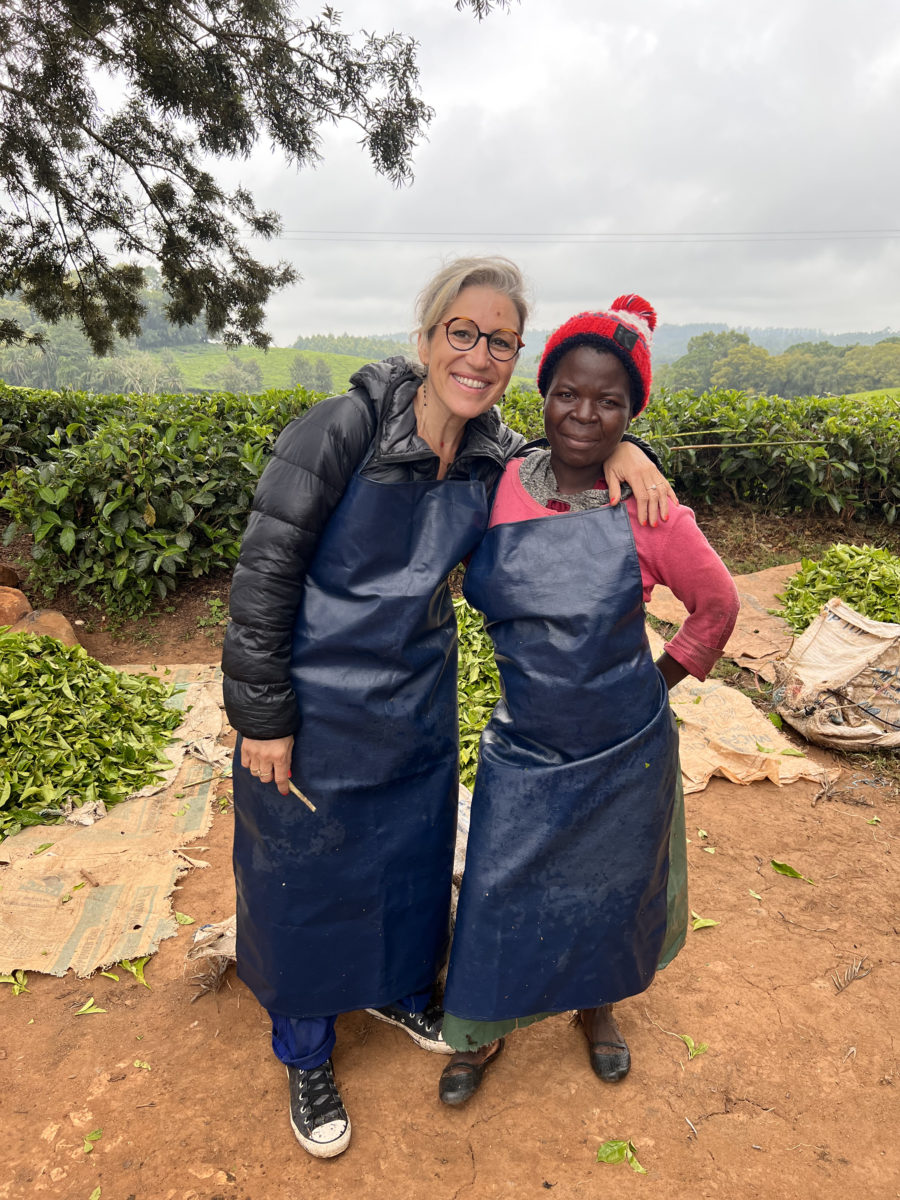
Anne: Is your indoor weather related to the outdoors and the season?
Carine: A little bit but not all the time. It is linked to events and feelings. When the sun comes, I have a lot of fun having a green tea or a spring Darjeeling with its cooler, brighter notes. And when it’s a little rainy, the warmer, maltier notes and brown honey of some Chinese or Nepalese black teas comfort me. But it’s not just that.
Anne: And not Assam, oddly enough?
Carine: Well, no, and yet I love them, but it’s very intuitive.
Anne: Did some teas cause you problems at first? Were there styles you struggled with which you came to a mutual understanding?
Carine: Yes. Often when we ask this question, Pu’er is the answer. But I was immediately touched by Pu’er because I have a long history of tasting them, even small. The teas that may have caused me problems because they spoke to me less at the beginning are Chinese green teas. I felt there was something, but I felt less of the aromatic explosion. There was a moment of adaptation, of gaining understanding. I think what changed was to go there and connect with the terroir, the people, and the process. I understood, and it changed everything. In the beginning, I tasted them more in the automatic description. I had less of a global understanding. Today, we have found each other.
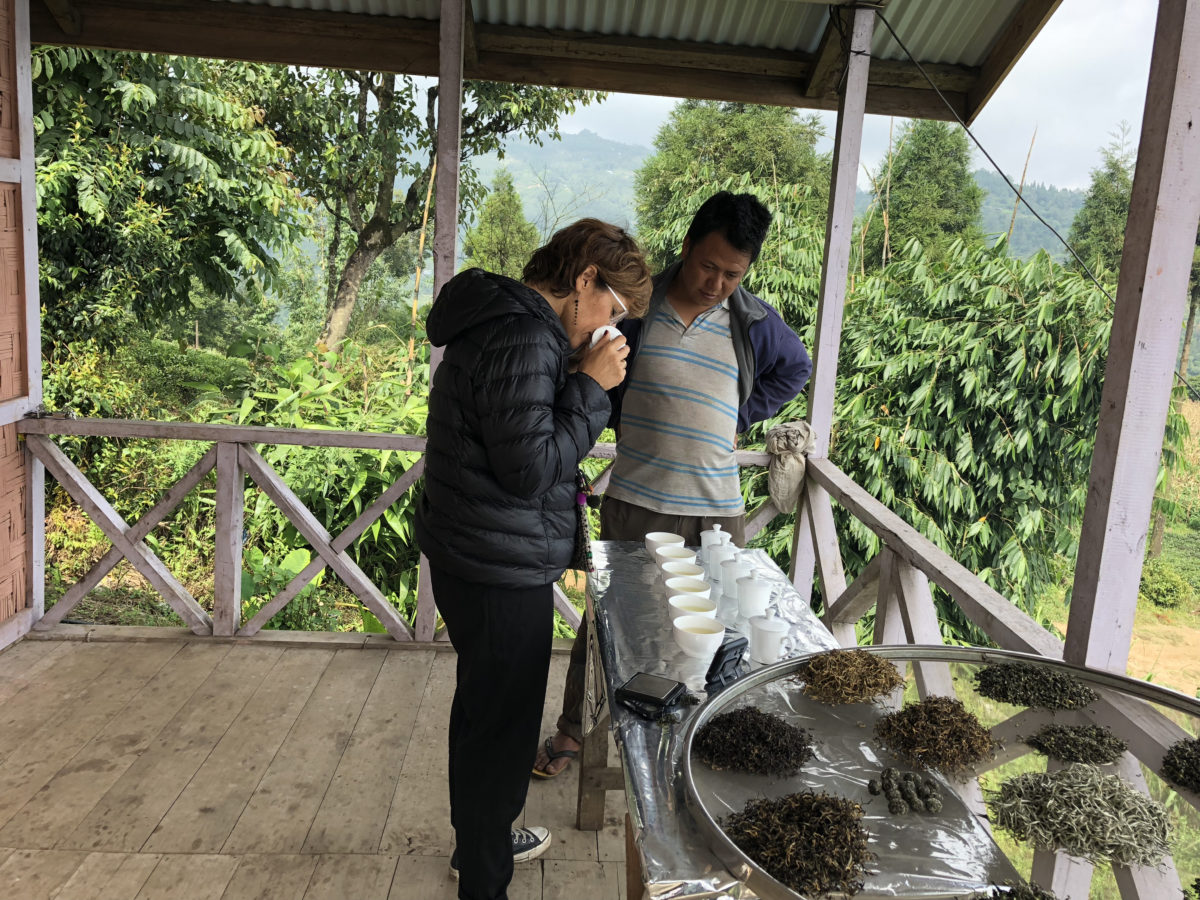
Anne: Does knowledge of these terroirs play a role in understanding these teas, how you appreciate them, and how you feel them?
Carine: Definitely, yes. I am fortunate to be able to travel very regularly and work with the producers. It is searching for understanding, such as a study trip and connection with people. For me, it’s one. I was miserable not being able to travel during this period (editor’s note: pandemic). I am also responsible for buying tea. When you buy, you buy a whole. When you are on-site, you completely understand the product. The terroir and process are both keys in the expression of the aromas and even the overall profile. I don’t feel tea the same way when I can make the connection. It allows me to explain it better and be more relevant in my selections.
Anne: Could you share how you have developed your tea vocabulary related to your training and your initial profession? How did you go from identifying “something familiar,” perhaps linking it to a similar experience or place, to the ability to assign it a specific term?
Carine: Given my background, I even went in the opposite direction. In the studies and practice that I was able to do at the beginning, we generally deviated from the feeling, particularly from “I like / I do not like” We left in the absolute from the memories that were associated with this smell (because it was too personal) to understand the odorous molecule. That is to say, each odorous molecule that is present in the product is analyzed. The fact that I have analyzed molecules for many years allows me to dissect the product well. On the other hand, it is not accessible. When I started working in one of the teas, it was complicated to say that it smelled like linalool, isoamyl acetate, etc. So I had to re-impregnate myself with language, and from there, I worked on developing a language that used common terms. The language is in nature. There is the language of emotion linked to memories. We associate a smell with memory.
On the other hand, when we want to develop a common vocabulary accessible to all, we cannot use a vocabulary linked to memories because they are too personal. There are three possible readings and interpretations. First, we can talk about the odorous molecule in the product. This reading is exact and not very accessible except to people in the trade. The other reading is slightly broader as these compounds are in nature; therefore, we use nature as a reference for vocabulary. We first speak of the olfactory family and then describe the type of note more and more precisely. For example, we first talk about a floral note, then specify with a linden note, a jasmine note, honeysuckle, rose… The last possible reading is the interpretation of emotions or the memory, “it reminds me of such a thing.”
Anne: In your experience, are there areas that seem more accessible or more difficult for the neophyte?
Carine: What is interesting is to see that the world of smells is closely linked to our experience. We work on memory. It’s fascinating to see the formulations that everyone describes with different terms. My role is to understand each one and say, “you are actually talking about the same compound.” So there is no wrong answer. One must only try to understand the right and common words that can be associated. By experience, what is sometimes more complicated to define is everything that is, strangely, in the field of flowers. We have something specific in what is food (fruits, herbs, spices, etc.) and less in the world of flowers, where we are less accustomed to feeling consciously. I have noticed this in the various tastings.
Anne: In other countries, when you meet strangers, do you find that their way of apprehending smells is different?
Carine: Absolutely! For example, I am working on an aroma wheel in the world of tea. There are plans to adapt it according to the countries. From the moment we take nature, we take the habits of each country. In France, we have strawberries, raspberries, blackcurrant, and apricots. It is not the case everywhere. I was recently in Malawi; for example, there is not the same understanding, which sometimes can create misunderstandings. We talk about the same thing but do not describe it correctly. And therefore, we say that there is no such note, but we still agree that the word given is incorrect. Yes, from the moment we generalize, there is a work of adaptation according to the cultures.

Anne: What advice would you give to someone looking to progress?
Carine: To better feel and perfect your sensitivity, it’s very easy, and it’s very pleasant, yet it is not done systematically. It is to be aware that we have a nose and a good nose to use it. It’s constantly being a little conscious, even when walking down the street, even in Paris. Yes, there are bad smells, but they are smells. Being nose to the wind, capturing smells and memorizing them. In the same way, I tell my students at the perfume school that the best learning is to cook, to smell the fresh butter, to heat it, to feel all the reaction that happens, the smell that will change, to eat an apple, very simple foods, but to be there saying “I eat an apple” We carry out a tasting in full consciousness. It allows us to be more efficient in perceiving things, especially memorizing what we perceive. At the time of this conscious tasting, we put in a box the olfactory perception, and we associate it with “that’s an apple.” When we redo tastings on tea, we will have perceptions and make the connection. The further we go, the easier we recognize — the more words we put into terms of what we perceive, the more things we perceive. I think you’ve already had this experience when you sense a perfume and can’t put a word to it: “But what is it? What’s that? The brain wants the solution, so it will get stuck on the search for olfactory memory. If we continually feed our memory joyfully, by feeling things, by eating consciously, we train the nose and the brain and progress. During tea tastings, we find the notes memorized; in this way, we say to ourselves, “Here! There I recognized… etc.
Anne: To go through this process, is it better to focus on a tea and go to the end of that tea or do comparative tastings? For example, take three or four teas and go from one to the other…
Carine: I want to tell you both. In my training, I really do both – the two are complementary. You can do both or one after the other. When there are tastings on a theme, for example, on all the spring Darjeeling, it is fascinating to analyze them individually. We are in a position where we decipher everything, we enter into exploration in the tea, and at that moment, we can feel all the nuances. We do that with différent teas. Then, we take these same teas and taste them afterward in comparison. When we taste them in contrast, we will saturate ourselves with the expected notes, and the differences will emerge. So we’re going to have a perfect comparison of tea because we’ve explored it beforehand and then put it in context with other teas. Sometimes, when you are on a tasting with people who are less initiated to tasting, it is much easier to do it in comparison. Because precisely, it is the different notes that stand out. So in a tasting for people who are not initiated, the ideal is to put a white tea, a green tea, an oolong, a black tea, and even a dark tea, which each have different olfactory universes, and even texture. The contrast makes it easy to perceive.
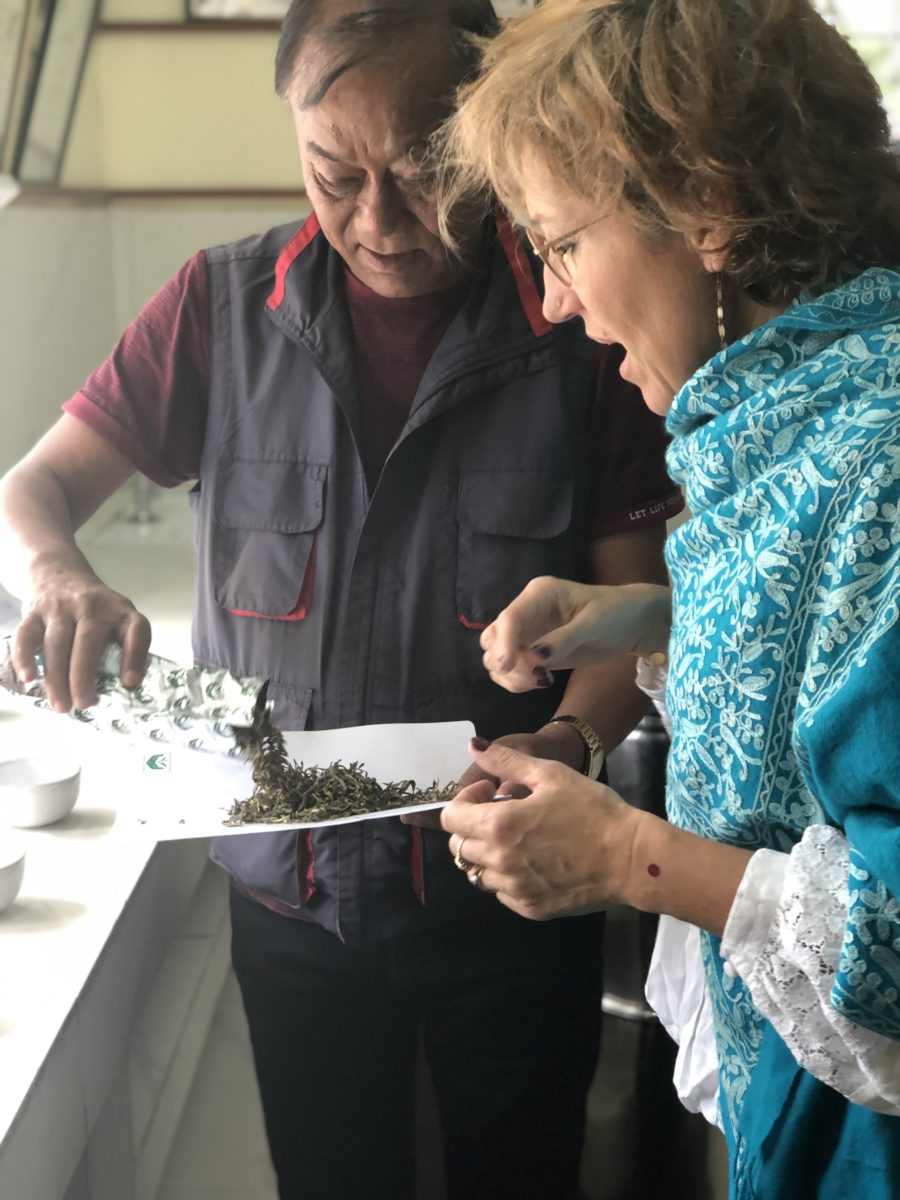
Her works
The QuintEssence of Tea: Sensory box to help with tea tasting
La Cuisine au Thé, co-written with Michelin-starred chef Sylvain Sendra, Edition Agnès Vienot L’Instant Cru, Marie Sophie L., pairing tea and food.
Anne: Could you tell us about your role as president of the jury of the AVPA competition?
Carine: It’s topical since the applications will arrive during the summer. Producers have until the end of August to send samples. The competition will take place in September. I am delighted with this collaboration with the AVPA! Congratulations to them for this great initiative. It is a lot of work. The goal is to value the work of producers. Sometimes the tea houses will be an intermediary and will make it possible to finance the participation while highlighting the producer and his teas. The role of the AVPA is to promote, accompany, and make known all the work of the people who produce tea. It is also to make people aware that there is a plant in the cup of tea, and there are men who work both on the culture and the process. It is both an expertise and a talent. The producers and the tea makers are real artists. As president, my role is to help and be at the side of the AVPA to promote producers, seek, represent, and be an ambassador of this approach. It is easier to go to countries quite regularly. It is something that’s touching to me because it really fits with the way I see tea. Tea is the person who produces it must be highlighted. My role as president is also the organization of applications.
Once you receive all these samples (there are more than a hundred), you have to think about categories. Indeed we can not judge all teas at the same level. You can’t compare white tea and black tea. There is a need to understand the whole range and organize by category the teas that will be judged. There is also a coordinating role with the jury. Care must be taken to ensure that the assessment is done correctly. The goal is to judge each tea and that each tea has the same attention so that it is fair. We must be fair and value all the products that need to be valued with the same attention. Finally, my role can extend after the competition by handing over the diplomas, according to my travels. It’s nice to see the importance that medals have for them, and I understand that because we value their work. There is a pride that is right, that is justified.
Anne: This year, will you have any European teas? Already know that?
Carine: I don’t know. I’m sure there will be French teas, at least I hope so! There was some last year. Maybe Jersey teas, too, as some were entered last year.
Anne: Finally, do you have a brilliant memory of a particular tea that continues to follow you?
Carine: Yes… maybe two teas. But it was the first emotion. I admit that, fortunately, I have regularly enough. All of a sudden, it touches me. It’s the magic of the job. I have two that come to mind. One tea from the Arya Tea Estate is the tea I am drinking now. Buddhist Monks founded the garden. It was the first time I tasted AV2, a quite renowned varietal. It was a long time ago. It was almost 18 years ago, I think. It was the first time I tasted this note, and this sweetness, this richness completely moved me; this tea was a little milky, a little coumarin. I remember precisely the moment I tasted it, again in my mouth the feeling of “wahoo” both for this garden and for this type of tea; there is always an attraction.
The second is oriental beauty. The first time I tasted it, it was in Taiwan with the farmer that grew the tea. It was an award-winning tea (they have competitions locally) and was amazing. I came from the world of perfume, and I told myself that it was perfection in complexity. I admit that I have never found in an oriental beauty of such perfection. I cannot find that quality. So these two teas have done me a lot of good and continue to feed my memory.
Tasting Notes
Nom du thé: Sundara Gira
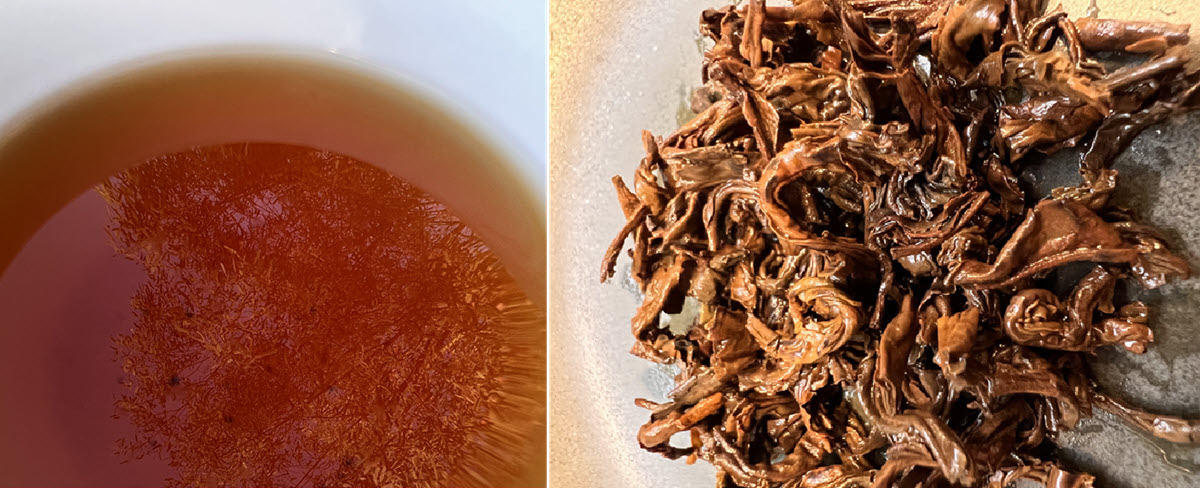
Origine: Népal, Ilam, village de Jasbire
Altitude: 1800 mètres
Producteur: Sharad Shuba
Cultivar: Goomtee et autres cultivars
Feuilles sèches: très fruité, fruit compoté (pruneau, confiture de fraise), vanillé (gousse de vanille), boisé (bois ciré), miellé, note pyrogénée (praliné, pain grillé), nuance agrume (orange confite), nuance florale (rosé)
Profil sensoriel: La texture très ronde, lisse, presque huileuse ainsi que la saveur sucrée renforcent le pôle gourmand. L’attaque boisée et pyrogénée (grillé, praliné, cacao) est suivie par un pôle fruité (fruit compoté, pruneau, fraise, …), accompagné de notes de vanille et des nuances d’agrume (orange confite, bergamote) et de rose.
Ce thé en quelques mots: boisé, praliné, fruits, confiture, rond, facile à boire.
Process : les étapes du thé noir parfaitement maitrisées avec un flétrissage, un roulage, une oxydation, un séchage assez profond
Conseils de préparation: Préparation en théière 6 à 8 g pour 40cl avec une eau filtrée à 90°C durant 4’ | En gaiwan, vous pouvez concentrer le dosage et infuser 20 secondes au départ afin d’apprécier les premières effluves, puis augmenter progressivement le temps d’infusion pour découvrir toute la palette aromatique.
Notes personnelles: ce thé me touche particulièrement car il mêle la richesse des arômes tout en restant très facile d’accès. J’admire le talent du tea maker, Sharad, et j’apprécie tous les fermiers de ce village en particulier Susma et Purna Mukyia, qui est aujourd’hui comme une famille. La qualité du terroir de ce village permet d’offrir des thés toujours riches en arômes quelques soit la couleur.
Website https://nunshen.com
See: Tea Processing at Innovative Jasbire Tea Factory
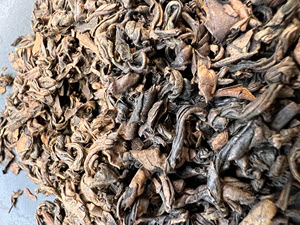
English Translation
Dry leaves: very fruity, stewed fruit (prune, strawberry jam), vanilla (vanilla pod), woody (waxed wood), honeyed, toasted note (praline, toast), citrus nuance (candied orange), floral nuance ( pink)
Sensory profile: The very round, smooth, almost oily texture, as well as the sweet flavor, reinforce the gourmet pole. The woody and toasted attack (grilled, praline, cocoa) is followed by a fruity note (stewed fruit, prune, strawberry, etc.), accompanied by notes of vanilla and nuances of citrus (candied orange, bergamot) and rose.
This tea in a few words: woody, praline, fruit, jam, round, and easy to drink.
Process: the stages of black tea are perfectly mastered with withering, rolling, oxidation, fairly deep drying
Preparation advice: Preparation in a teapot 6 to 8 g for 40cl with filtered water at 90°C for 4’ | In a gaiwan, you can concentrate the dosage and infuse for 20 seconds at the start to appreciate the first scents, then gradually increase the infusion time to discover the full aromatic palette.
Personal notes: this tea particularly touches me because it combines the richness of aromas while remaining very easy to access. I admire the talent of the tea maker, Sharad, and I appreciate all the farmers in this village, especially Susma and Purna Mukyia, which today are like a family. The soil quality of this village makes it possible to offer teas that are always rich in aromas, whatever the color.
Nom du thé: Arya Diamond (second flush)
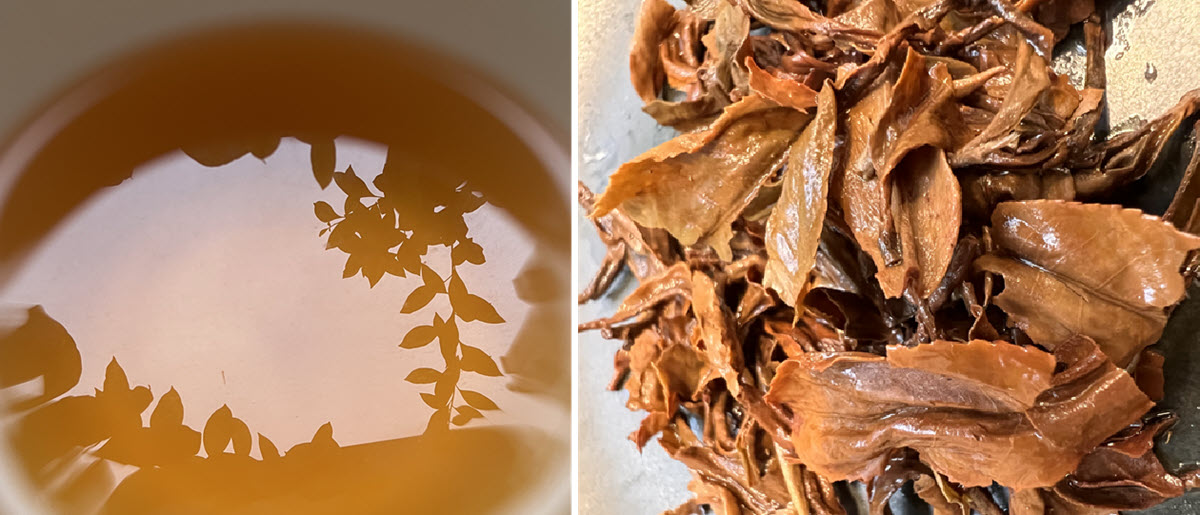
Origine: Inde, Darjeeling
Altitude: 1700 mètres
Producteur: Mister Subhasish Roy
Cultivar: AV2
Feuilles sèches: très floral, miellé, boisé, malté, pic zesté et épicé (girofle, cannelle), fruits secs (raison sec, figue)
Profil sensoriel: Les notes sont riches et complexes. Dès l’attaque le bouquet floral, très caractéristique, nous envoute avec ses notes de rose et de tilleul. Les parfums se développent ensuite sur des notes de miel, de cire, de bois (doux, santal) et de malt. Des nuances de vanille (sucre vanillé), de figue fraiche, de coumarine et de fève tonka apportent douceur et profondeur et se mêlent avec les notes de fruits secs (figue, raisin sec) et d’épices en longueur. La texture onctueuse et finement astringente en longueur vient soutenir tous ces arômes
Process: les étapes du thé noir parfaitement maitrisées avec un flétrissage, un roulage, une oxydation puis un séchage.
Conseils de préparation: Préparation en théière 6 à 8 g pour 40cl avec une eau filtrée à 80°C durant 4’ | En gaiwan, vous pouvez concentrer le dosage et infuser 20 secondes au départ afin d’apprécier les premières effluves, puis augmenter progressivement le temps d’infusion pour découvrir toute la palette aromatique jusqu’à laisser les tanins de diffuser et soutenir les arômes.
Notes personnelles: Le manager Mister Subhasish Roy, tel un artiste, sait exprimer dans ses thés toute la richesse du terroir et de la typicité des cultivars. Chaque fois que je déguste ce type de thé, je me souviens de la première fois où je l’ai dégusté. La richesse et la complexité des arômes, les notes très reconnaissables de tilleul, de rose, de coumarine, liées avec une texture à la fois présente mais aussi très douce rendent la dégustation de ce thé très touchante. Ce thé a remporté la médaille d’or au concours de l’AVPA en 2021
Website https://nunshen.com/arya-diamond.html
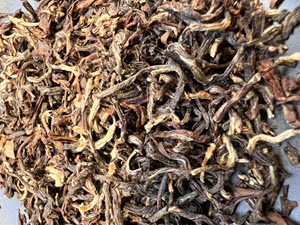
English Translation
Dry leaves: very floral, honeyed, woody, malty, zesty, and spicy peak (clove, cinnamon), dried fruits (raisin, fig)
Sensory profile: The notes are rich and complex. From the start, the very characteristic floral bouquet bewitches us with its rose and lime blossom notes. The flavors then develop into notes of honey, wax, wood (sweet, sandalwood), and malt. Nuances of vanilla (vanilla sugar), fresh fig, coumarin, and tonka bean bring sweetness and depth and mingle with notes of dried fruits (fig, raisin) and spices in length. The unctuous and finely astringent finish supports all these aromas.
Processing: The stages of black tea processing are perfectly mastered with withering, rolling, oxidation, and drying.
Tips for preparation: Preparation in teapot 6 to 8 g for 40cl with filtered water at 80°C for 4 minutes. | In a Gaiwan, you can concentrate the dosage and infuse for 20 seconds at first to appreciate the first scents, then gradually increase the infusion time to discover the full aromatic palette until the tannins diffuse and support the aromas.
Personal Notes: The manager Mister Subhasish Roy, like an artist, knows how to express in his teas all the richness of the terroir and the typicality of the cultivars. Every time I taste this type of tea, I remember the first time I tasted it. The richness and complexity of the aromas, the very recognizable notes of linden, rose, and coumarin, linked with a texture that is present but also very soft, make the tasting of this tea very touching. This tea won the gold medal at the AVPA competition in 2021
1 thought on “Taster Profile: Carine Baudry”